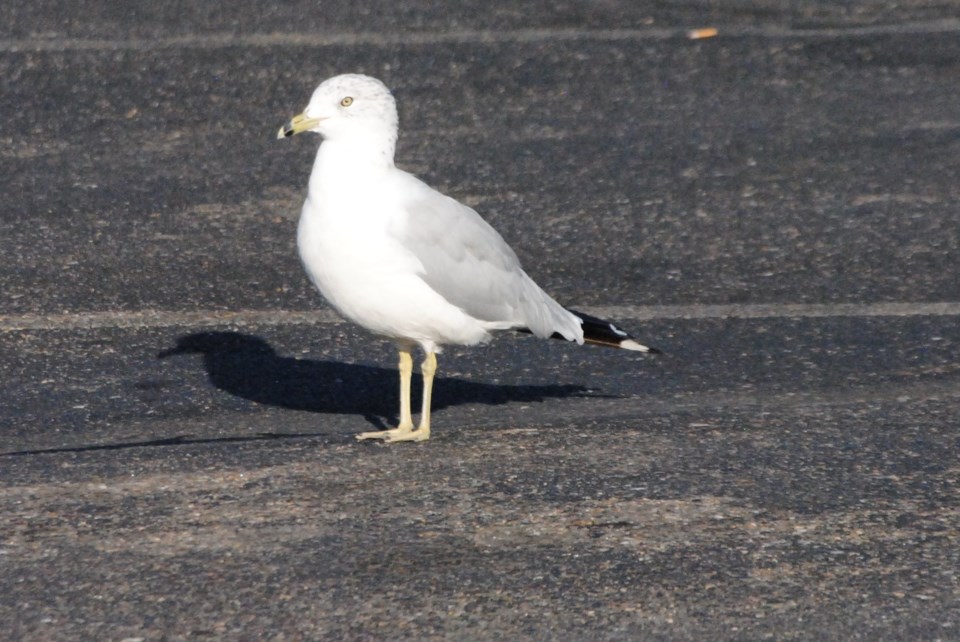This content was originally published by the Longmont Observer and is licensed under a Creative Commons license.
Hundreds of gulls used to follow my father’s tractor in the field in the fall as he harvested crops and plowed. I used to wonder why there were gulls in the middle of Minnesota, far away from the ocean. The other day, I saw the first of the gulls returning to Longmont. The short answer to why they are here is that they migrate through Colorado on their way to their wintering grounds. Some of them will stay here throughout the winter. Although several gull species can be seen in Colorado, the one you are most likely to see in Longmont is the ring-billed gull.
The ring-billed gull is aptly named for the ring of black that appears around the bill. However, it can be easy to confuse the ring-billed gull with the California gull because they both have black on their bills. The California gull has a red spot on the bill in addition to the black ring. Breeding adult ring-billed gulls have a white head, body, and tail with gray on the back. Their wingtips are black and are spotted with white, and they have yellow bills and legs. Non-breeding adults (such as adults in the fall and winter) have a head that is streaked with brown. Ring-billed gulls do not obtain adult plumage until three years of age. Juvenile plumage is a mixture of brown and grey and the bill and legs are pink.
Ring-billed gulls have adapted very well to humans and can now be found just as easily scavenging for food in a fast food parking lot as on a lake. Gulls are typically found near water, but they actually do most of their foraging for food away from the water. You can find gulls in town, at garbage dumps, golf courses, and in farm fields. Ring-billed gulls use fresh water lakes and streams just as much as they use salt water sources and may actually prefer fresh water.
Ring-billed gulls are able to survive on a wide variety of foods. They most often eat insects, worms, grain, rodents, and garbage. They will also eat fish, but this is rarer in the western United States. Because they are opportunistic, ring-bills gulls have also been known to eat fruit when they find it. At one place where I worked in Washington, there was a local french fry factory that was frequented by gulls. Research has shown that when landfills move away from open dumps to incinerators, the local gull population decreases. Ring-billed gulls are also known to steal food from other birds.
Ring-billed gulls are strong flyers, capable of speeds up to 40 miles per hour. They can catch food while in flight, but also use other strategies for hunting. Ring-billed gulls are capable of hovering while they hunt for food, but they also hunt while walking or swimming.
Ring-billed gulls nest in colonies consisting of 20 to thousands of pairs which can be a noisy affair as gulls call and bicker with a raucous mewing sort of cry. Pairs are usually formed before reaching the breeding grounds. Most gulls return to the colony they were born in to breed, often nesting within a few feet of the nest they used the previous year. During courtship, males and females will stretch upright and alternately face toward and away from each other. Females will often beg to be fed and the males will then feed the female.
Both the male and the female participate in nest building. The nest is a scrape on the ground and is located near water. The scrape in the ground is lined with twigs, grass, leaves, or moss. Nests are only about two inches deep, but range from nine inches in diameter for the inner cup to 25 inches in diameter for the outer cup. Although there is usually little vegetation in the area where the nests are located, gulls often put their nest near or under a nearby bush or other plant to hide it from aerial predators.
A clutch of eggs typically consists of two to four eggs, although they can lay as many as eight eggs. Nests that have more than four eggs are usually the result of two females nesting in a single nest which is a rare occurrence. Occasionally, a small stone about the same size, shape, and color of gull eggs can be found in the nest. Apparently, the stones may be mistaken for an egg that has rolled out of the nest. Only one clutch or group of eggs is laid per breeding season. Both pairs incubate the eggs. Eggs hatch in 20-31 days. The young are covered in feathers when they hatch and their eyes are open by the end of the first day. By day two, after hatching, the young may leave the nest. Young are out of the nest by day four or five. Both parents feed the young. The young are able to fly by five weeks after hatching and become independent of their parents shortly after that.
Ring-billed gulls will be migrating through Longmont very shortly. In fact, a few have already started to show up. I usually see at least some that spend the winter here as well. Look for ring-billed gulls in parking lots such as those in grocery stores or fast food places. You may also see them on top of light posts where it is warm during the winter. Keep an eye out for these interesting migrants.



